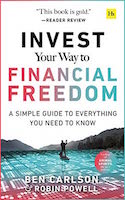This is about a day in my post-FIRE ((Financial Independence Retire Early.)) life and how achieving financial independence changed everything.
So it begins
Pre-FIRE
The summer holidays are over. It’s nose to the grindstone now from late August until late October. Day in, day out.
Post-FIRE
A friend wonders if I’m around for a bike ride next week? I can do that!
Just another day
Pre-FIRE
I internally rage at the injustice of a September day drenched in sunshine when I’m stuck in the office. Too many of my August days off were just drenched.
Post-FIRE
We’re not tied to a schedule, so we pick the best day of the week for the ride. This is how to play the British weather lottery…
My favourite waste of time
Pre-FIRE
I’m stuck in the meeting time forgot. Theoretically it’s about strategy. In reality, a higher-up is chucking time on a bonfire, talking about things that will never happen, because they want to feel in control.
Post-FIRE
I’m cycling through a sunny country lane with a good friend, gassing about nothing. Occasionally we’re stunned into silence by the views.
This is a crisis!
Pre-FIRE
A client sends cryptic feedback. Our work isn’t impactful enough. Can we make it pop? They want something more viral. (I’ll give them something more viral.) The day is derailed. I’ll be dealing with this long into the evening.
Post-FIRE
We’ve dragged our bikes halfway up a muddy hill when some cows want their cowpath back. Fair dos, they’re bigger than us. But the embankments are choked with man-eating nettles. We curse, slide, and laugh our way back down.
Mothers shepherd their newly minted calves past us. The babies are cute as buttons! One little nipper springs by – full of beans on slippery stones. You go girl. Another’s very cautious and needs a nudge from mum. Aw.
Losing it
Pre-FIRE
A member of the team has lost their confidence. Another has lost their password. Still another their laptop. I’m losing my mind.
Post-FIRE
I spot some tasty-looking blackberries. Sweet! What’s this? A wee calf abiding in the undergrowth. Oh, hang on. She’s separated from the herd we met earlier. Where’s her mum? The calf is still, silent, and breathing very fast. Does that mean she’s stressed?
We wander about and find some people: “Do you know anyone from the farm? There’s a lost calf.”
They call the farmer. The calf is only two-days-old and not in a good place. The farmer arrives on a quad bike rescue mission. Cheers all round.
Refuelling
Pre-FIRE
I bung some batch cooking into the office microwave. Ding!
- Sit down at desk.
- Triage emails.
- Shovel in food.
So fast, I don’t even taste it.
Post-FIRE
We find a cafe. Coffee and cake you say? Okay, I reckon we’ve earned it. The weather is perfect. One of those warm, late summer days you could sit in forever.
We share some banter with the people at the next table. They’re cyclists, too. Lovely couple, we swap stories and spin yarns. I’d never have met them in my old life.
One last push
Pre-FIRE
It’s late afternoon. There’s still an email mountain to climb plus the work I was actually meant to do today. The deadline is as immovable as those cows will be in my future.
I text Mrs Accumulator to say I’ll be back after she’s gone to bed. I’m not sure I can keep going like this.
Post-FIRE
My friend says: “I’m not sure I can keep going.” The gradient hurts like a chemical burn.
I can see on the GPS that flat land is just around the bend:
“Not far now…” [Gasp]
“Keep going…” [Wheeze]
“You can do it…” [Kill me now]
My companion takes the lead. God, if he’s going to do this then so am I.
We made it! We’re cackling like eejits.
Who cares that we got to the top? Only us. We’re not setting any land speed records but we didn’t give up.
What a day: pre-FIRE vs post-FIRE
Pre-FIRE
I’m back home in the dark. The gauge on my spiritual oxygen tank hovers in the red zone.
My mind has been sand-blasted to sterility. I don’t want to talk. Which is lucky because Mrs Accumulator is trying to sleep.
What kind of life is this? I suppose I’m fortunate to have a job.
Post-FIRE
I’m back home in the sunshine with loads of energy still in the tank. My mind is buzzing and my spirits soar like a gospel choir.
I tell Mrs Accumulator about the cows. And I tell myself to remember.
I have the good fortune to live in a beautiful part of the world and have friends and family to share it with. What more do I need?
Take it steady,
The Accumulator








